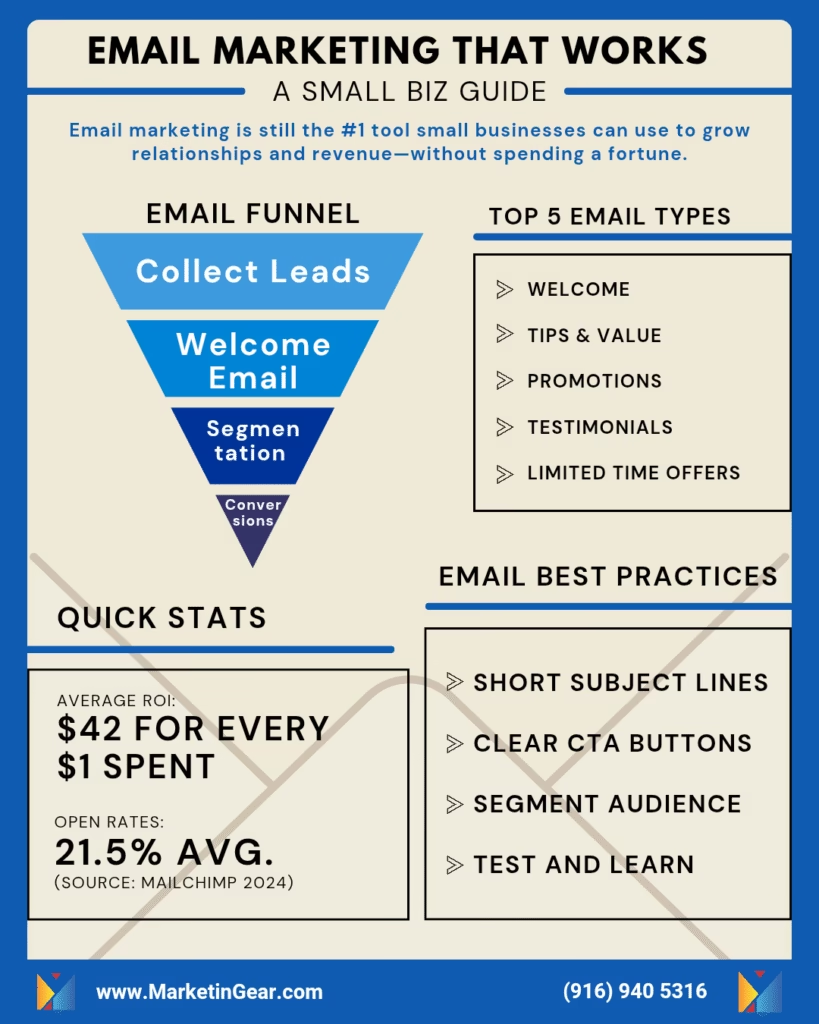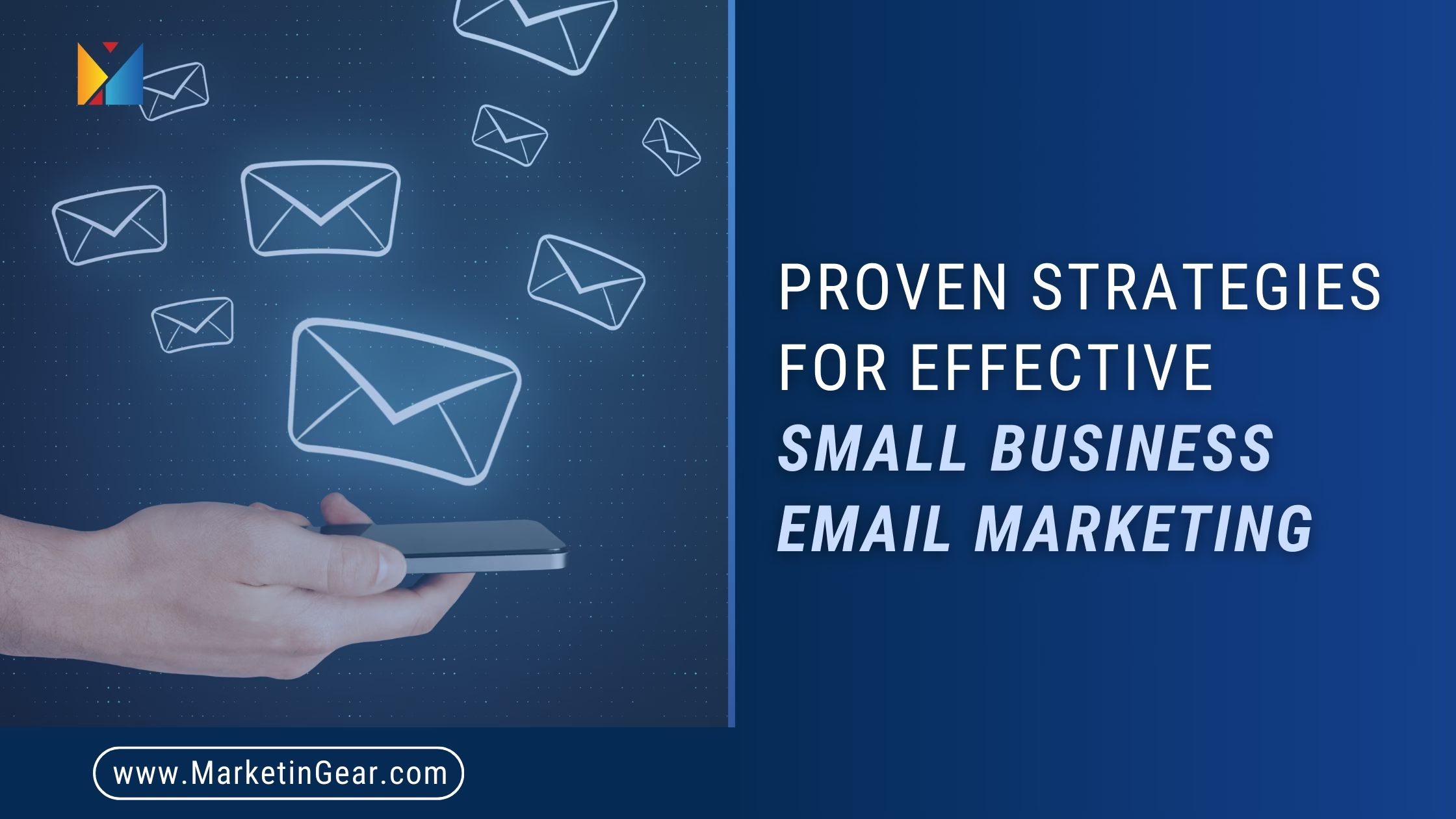Introduction: Why Email Marketing Still Works
You’ve probably heard it before—“email is dead.” But here’s the truth: email is far from dead. In fact, it’s one of the most powerful tools small businesses can use to build real relationships, grow sales, and stay top-of-mind with customers.
Think about it. Unlike social media posts that can get buried in a sea of updates, your emails land directly in someone’s inbox—a personal space. That’s like being invited into their digital living room. You wouldn’t barge in and shout; you’d smile, speak warmly, and share something worth their time. Email gives you a chance to do just that.
And here’s the kicker—email marketing gives you full control. You’re not at the mercy of algorithms. You own your list. You get to talk directly to your audience. And when done right, it works like a charm.
In this guide, we’ll walk you through email marketing strategies that actually work—even if you’re starting from scratch. We’ll keep things easy, practical, and fun. Think of it like a recipe for success that anyone can follow.

Section 1: Build a List the Right Way
Before you send out those beautifully crafted emails, you need people to send them to. But here’s your first big rule: don’t buy an email list. It’s like inviting strangers to your birthday party—awkward and kind of creepy.
Instead, build a list of people who actually want to hear from you. These are the people most likely to become loyal customers.
Actionable Tips:
- Use lead magnets. Give people a reason to sign up. Offer a discount code, a helpful free guide, a checklist, or even a fun quiz. Make it valuable and relevant to your business.
- Put your sign-up forms in smart places. Add them to your homepage, blog posts, product pages, and even as pop-ups (just don’t annoy people).
- Collect emails in person. If you have a physical store, use a tablet or a QR code at checkout. A friendly “Want 10% off your next visit?” goes a long way.
Storytime:
Jenny owns a cozy dog grooming shop. She offered new customers a “10% off your next visit” coupon in exchange for their email. In just 3 months, her list grew from 50 to over 500 subscribers—and she started getting repeat bookings like never before.
Section 2: Craft Emails That Actually Get Opened
Now that you’ve got a list, how do you make sure people actually open your emails?
Think of your subject line as a storefront window. If it’s boring, people walk by. If it’s inviting or sparks curiosity, they step inside.
Tips to Boost Open Rates:
- Keep it short and curious. Example: “Oops, did you forget this?” or “You’ve got a gift waiting ”
- Use the reader’s name. Personalization boosts open rates. “Hey Sarah, here’s something special for you.”
- Try emojis (if it fits your brand). They can grab attention—but use them sparingly.
- Don’t forget preview text. That little snippet that shows up after the subject line is your second chance to hook them.
Pro Tip: Think like a human, not a marketer. Would you open the email? If not, change it.
Section 3: Email Campaigns That Convert
Opening your email is one thing. Taking action is another.
Here’s how to turn your emails into sales without sounding pushy:
Conversion-Driven Email Ideas:
- Welcome Series: Introduce yourself, tell your story, and offer a small thank-you gift or helpful resource.
- How-To Guides or Product Tips: Show how to get the most out of what they bought.
- Limited-Time Offers: Use urgency with subject lines like “Last Chance!” or “Only 24 Hours Left!”
- Customer Stories: Share testimonials or success stories. Real people + real results = real trust.
Bonus Tip:
Always include one clear CTA (Call-To-Action). Don’t make readers guess. Whether it’s “Shop Now,” “Claim Your Discount,” or “Read More,” make the next step obvious.
Section 4: Segment Like a Pro (Even If You’re New)
Not all subscribers are the same. Some are new, some are regulars, and some haven’t opened your emails in months. That’s where segmentation becomes your best friend.
Imagine getting a promo about cat food when you only have a dog. Annoying, right?
How to Segment Your List:
- By purchase history: Send refill reminders or special thank-yous to loyal buyers.
- By behavior: Follow up with people who clicked but didn’t buy.
- By interest: Ask subscribers what they want to hear more about when they sign up.
Why It Matters:
Segmented campaigns get more than double the clicks compared to generic ones (Campaign Monitor says so!).
Section 5: Tools to Make Email Easy & Affordable
Good news—you don’t need to be a tech wizard or break the bank to get started.
Best Tools for Small Businesses:
- Mailchimp: A great all-rounder, free for small lists.
- Moosend: Simple, affordable, and packed with features.
- MailerLite: User-friendly with drag-and-drop design and automation.
- ConvertKit: Fantastic for creators and solopreneurs who want clean, purposeful emails.
Pro Tip: Start with one tool. Learn it well. Grow into it. Most platforms offer templates, automation, and analytics—even on free plans.
🔄 Section 6: Lead Nurturing Like a Human, Not a Robot
Imagine dating someone who only texts when they want something. Yuck, right? That’s how many businesses treat their email list—only showing up when it’s time to sell.
Let’s do better.
Nurturing Tips:
- Send value-driven emails: tips, how-tos, behind-the-scenes, or even just a heartfelt thank-you.
- Share stories—your journey, customer wins, funny fails. Be human.
- Create automated sequences that build trust before asking for the sale.
Try This 5-Email Nurture Sequence:
- Welcome email: Introduce yourself and say thank you.
- Value tip #1: Share something helpful or inspiring.
- Personal story: Connect on a human level.
- Value tip #2: More helpful content.
- Offer email: Invite them to take the next step.
People buy from people they trust. Nurturing = trust.
Section 7: Measure, Test, Improve
Here’s the secret sauce to long-term email success: track your results and keep testing.
If you’re not looking at your numbers, you’re guessing.
What to Track:
- Open Rate: Aim for 20–30%. If it’s low, work on your subject lines.
- Click-Through Rate (CTR): 2–5% is solid. Make sure your CTA is clear.
- Conversion Rate: How many people actually take action (buy, sign up, etc.)
Try A/B Testing:
Send two versions of the same email with different subject lines or send times. See what performs better. Your audience is telling you what they like—you just need to listen.
Conclusion: It’s Time to Hit Send
Email marketing isn’t rocket science—it’s relationship building in your audience’s inbox. When you treat your subscribers like real people, share valuable content, and show up with heart, your emails become something they look forward to—not something they delete.
Whether you’re a solo entrepreneur, a tiny team, or a business on the rise, email marketing can be your highest-performing, most personal channel.
And the best part?
It’s affordable, measurable, and 100% yours. No algorithms. No noise. Just real conversations, real relationships, and real results.
So go ahead—hit send. Your future fans are waiting.




